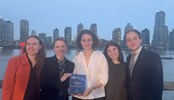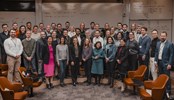Start bubble-hopping and gain important new perspectives
“Bubble-hopping is a method that aims to broaden our perspectives and cultivate a deeper understanding of people who are different from us,” Emma Stenström explains.
Emma Stenström is Associate Professor and Director of the Center for Arts, Business & Culture (ABC) at the Stockholm School of Economics. Combining arts and business has been her research interest since the early 1990’s – and bubble-hopping is a natural extension of that interest. In March this year she published a book on the topic, called Bubbelhoppa (Bubble-hopping in Swedish).
As part of her research Emma and her team let undergraduate and graduate students from Stockholm School of Economics step outside their own bubbles and meet imams and priests, artists and activists, drug dealers and people who sell sex, people from affluent and marginalized suburbs, homeless people, and millionaires.
“The most surprising has been how students, and other participants, have found the practice of bubble-hopping so useful. I have had around 2,000 people trying it out, and I am really surprised by the response. It is overwhelming. It is such a micro-practice, but apparently you can learn a lot from it. I have heard the most amazing stories over the years”, says Emma Stenström.
A way to learn from our differences
The term “bubble-hopping” is borrowed from former Google engineer Max Hawkins who creates algorithms to help us break out of our bubbles.
“To me bubble-hopping is first and foremost a mindset; a curiosity in people who are different than you”, says Emma Stenström and continues. “As human beings, we like to categorize and sort things. We need our bubbles. We need to feel security and belonging. But it is rewarding to make our bubbles wider, connect them with others and create foam, as I like to call it. When we find similarities and common ground, it is easier to make the best out of our differences. Differences are also good; the world would be terrible if we were all the same.”
Successful bubble-hopping starts with curiosity
To bubble-hop successfully, we first need to cultivate our curiosity. Being curious about what we don’t already know is the only way to bridge divides and the foundation for asking good questions.
“Curiosity is important, not the least in leadership. Bubble-hopping can help leaders to develop a type of curiosity referred to as ‘associative mind’. This is a type of curiosity that often needs to be enhanced in management circles”, says Emma Stenström.
Bubble-hopping benefits companies, individuals, and society
“I see bubble-hopping as a pedagogical method. Participants train skills like establishing trust, understanding biases, asking questions, listening, sharing, and showing intellectual humility. Then they do a bubble-hop and meet someone they want to understand better. Afterwards we reflect and share insights. It can sometimes be complicated and a little scary, but it is rewarding when it works”, Emma explains.
The answer to the question whether bubble-hopping can help us become better colleagues or leaders is yes. By putting ourselves in other peoples’ shoes we become more empathetic, innovative, and creative. Companies can use bubble-hopping to stimulate knowledge-sharing, creativity, and innovation, and also to bridge divides between different roles and departments within the organization. Further, it is a way for companies to build bridges between sectors, organizations, and professions, and to gain further understanding for their customers and the market.
“Bubble-hopping and similar bridging practices are also fruitful in leadership development. Being able to step into someone else’s shoes is of course important for leaders”, says Emma Stenström.
Having the courage and curiosity to bubble-hop is also very rewarding on a personal level. Bubble-hopping will not only increase our self-awareness, but it will at the same time broaden our perspectives and give us a more exciting life. We develop both professionally and as a partner, friend, or parent.
When we bubble-hop, we are also a part of bridging the divides between people in groups on a societal level. By being curious about other bubbles and actively talking about bubble-hopping in a non-polarizing way, we might contribute to a world with less worrying, hatred and conflict.
Bubble-hop into the future
To promote bubble-hopping in the future, Emma Stenström believes in concrete projects adapted for the context.
“I believe, of course, that schools are good places to start in. But also, sports, work life, and other places where we naturally meet each other”, she says.
Another path is international, through collaborations with other researchers in the field. Emma belongs to “Democracy & Belonging Forum”, which is a network created by UC Berkeley to connect “bridgers” across the globe. She will also serve as a researcher in residence at Georgetown University in Washington DC in the fall of 2023, where they have a similar initiative as bubble-hopping called “In your shoes”.
In the future, Emma looks forward to continuing her research within this field.
“I would like to do more experimental research around bubble-hopping in specific contexts. And I would also like to combine bubble-hopping even more with my major research field: arts and business”, she says.
Emma Stenström is Associate Professor at the Department of Management and Organization at Stockholm School of Economics. She is Director of the Center for Arts, Business & Culture (ABC) at the SSE Institute for Research (SIR).




